Incentives and Institutions
South Korea has a per capita GDP nearly 20 times higher than that of North Korea. Why? In one sense, we have just given an answer: South Korea has more physical and human capital per worker than North Korea.* But this answer is incomplete and partial. The answer is incomplete because we still want to know why does South Korea have more physical and human capital than North Korea? The answer is partial because poor countries like North Korea not only have less physical and human capital than rich countries, they also fail to organize the capital that they do have in the most productive ways. To understand the wealth of nations more deeply, we need to take a look at some of the indirect or more ultimate causes.
The example of South and North Korea is useful because we can rule out some explanations for the huge differences in wealth between these two countries. The explanation, for example, cannot be differences in the people, culture, or geography. Before South and North Korea were divided at the end of World War II, they shared the same people and culture—in other words, the same human capital. South and North Korea also had similar levels of physical capital—natural resources were about the same in the South as in the North, and if there were any advantages in human-made physical capital, they went to the North, which was at that time more industrialized than the South. When the two regions were split, therefore, South and North Korea were in all important respects the same, almost as if the split was designed as a giant social experiment.
South and North Korea differed in their economic institutions. Broadly speaking, South Korea had capitalism, and North Korea had communism. South Korea was never a pure capitalist economy, of course, but in South Korea the organizers of human capital, physical capital, and technological knowledge are private, profit-seeking firms and entrepreneurs to a much greater extent than in North Korea. In South Korea a worker earns more money if he provides goods and services of value to consumers or if she invents new ideas for more efficient production. Those same incentives do not exist in North Korea, where workers are rewarded for being loyal to the ruling Communist Party. In short, South Korea uses markets to organize its production much more than North Korea and so is able to take advantage of all the efficiency properties of markets discussed in Chapter 3 and Chapter 4.
Over fifty years later, the results of the “experiment” splitting North and South Korea are so clear they can be seen from outer space, as seen in Figure 7.6.
FIGURE 7.6
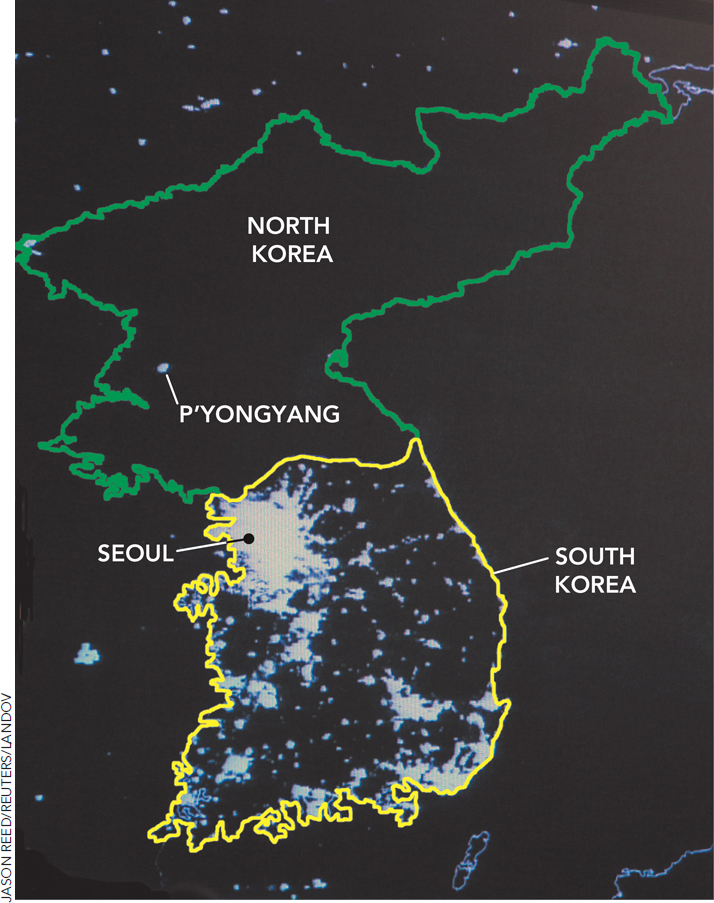
The experiment splitting South and North Korea is especially dramatic. But wherever similar experiments have been tried, such as in East and West Germany, or Taiwan and China, the results have been similar.
We said earlier that countries with a high GDP per capita have a lot of physical and human capital that is organized using the best technological knowledge to be highly productive. But factors of production do not fall from the sky like manna from heaven. Factors of production must be produced. Similarly, factors of production do not organize themselves. Physical capital, human capital, and technology must be combined and organized purposively to be productive.
Do you remember Big Idea One and Big Idea Two from the introductory chapter? These ideas were that incentives matter and good institutions align self-interest with the social interest.
Thus, we can now deepen our understanding of the wealth of nations. Countries with a high GDP per capita have institutions that make it in people’s self-interest to invest in physical capital, human capital, and technological knowledge and to efficiently organize these resources for production.
In short, the key to producing and organizing the factors of production are institutions that create appropriate incentives. Let’s look at institutions and the incentives that they create in more detail.
Institutions
Institutions are the “rules of the game” that structure economic incentives.
Institutions include laws and regulations but also customs, practices, organizations, and social mores—institutions are the “rules of the game” that shape human interaction and structure economic incentives within a society
What kinds of institutions encourage investment and the efficient organization of the factors of production? Understanding institutions is an important area of research in economics, and there is considerable agreement that among the key institutions are property rights, honest government, political stability, a dependable legal system, and competitive and open markets.
Institutions of Economic Growth
 Property rights
Property rights
 Honest government
Honest government
 Political stability
Political stability
 A dependable legal system
A dependable legal system
 Competitive and open markets
Competitive and open markets
Entire books have been written about each of these institutions and their roles in economic growth. Indeed, much of this book is about property rights and the benefits of open markets and rivalrous economic competition. Thus, we will give only a few examples here of how each of these institutions creates appropriate incentives, incentives that align self-interest with the social interest.
A free rider is someone who consumes a resource without working or contributing to the resource’s upkeep.
Property Rights When the Communist revolutionaries took control of China, they abolished private property in land. In the “Little Leap Forward,” they put farmers to work in collectives of 100-300 families. Communal property meant that the incentives to invest in the land and to work hard were low. Imagine that a day’s work can produce an extra bushel of corn. Thus, an extra day’s work on a commune with 100 families earned the worker 1/100th of a bushel of corn. Would you work an extra day for a few earfuls of corn? Under communal property, working an extra day doesn’t add much to a worker’s take-home pay and working a day less doesn’t subtract much. Thus, under communal property, effort is divorced from payment so there is little incentive to work—in fact, there is an incentive not to work and to free ride on the work of others. In the “Great Leap Forward,” the incentive to free ride was made even stronger when communes were increased to 5,000 families. But if everyone free rides, the commune will starve. Communal property in agricultural land did not align a farmer’s self-interest with the social interest. And, as a result of this and many similar errors on the part of the Chinese leadership, some 20-40 million Chinese farmers and workers starved during this period.
The Great Leap Forward was actually a great leap backward—agricultural land was less productive in 1978 than it had been in 1949 when the Communists took over. In 1978, however, farmers in the village of Xiaogang held a secret meeting. The farmers agreed to divide the communal land and assign it to individuals—each farmer had to produce a quota for the government but anything he or she produced in excess of the quota that farmer would keep. The agreement violated government policy and, as a result, the farmers also pledged that if any of them was sent to jail, the others would raise his or her children. The remarkable secret agreement of the Xiaogang farmers is shown at left.
The change from collective property rights to something closer to private property rights had an immediate effect: Investment, work effort, and productivity increased. “You can’t be lazy when you work for your family and yourself,” said one of the farmers.
Word of the secret agreement leaked out and local bureaucrats cut off Xiaogang from fertilizer, seeds, and pesticides. But amazingly, before Xiaogang could be stopped, farmers in other villages also began to abandon collective property. In Beijing, Mao Zedong was dead and a new set of rulers, seeing the productivity improvements, decided to let the experiment proceed.
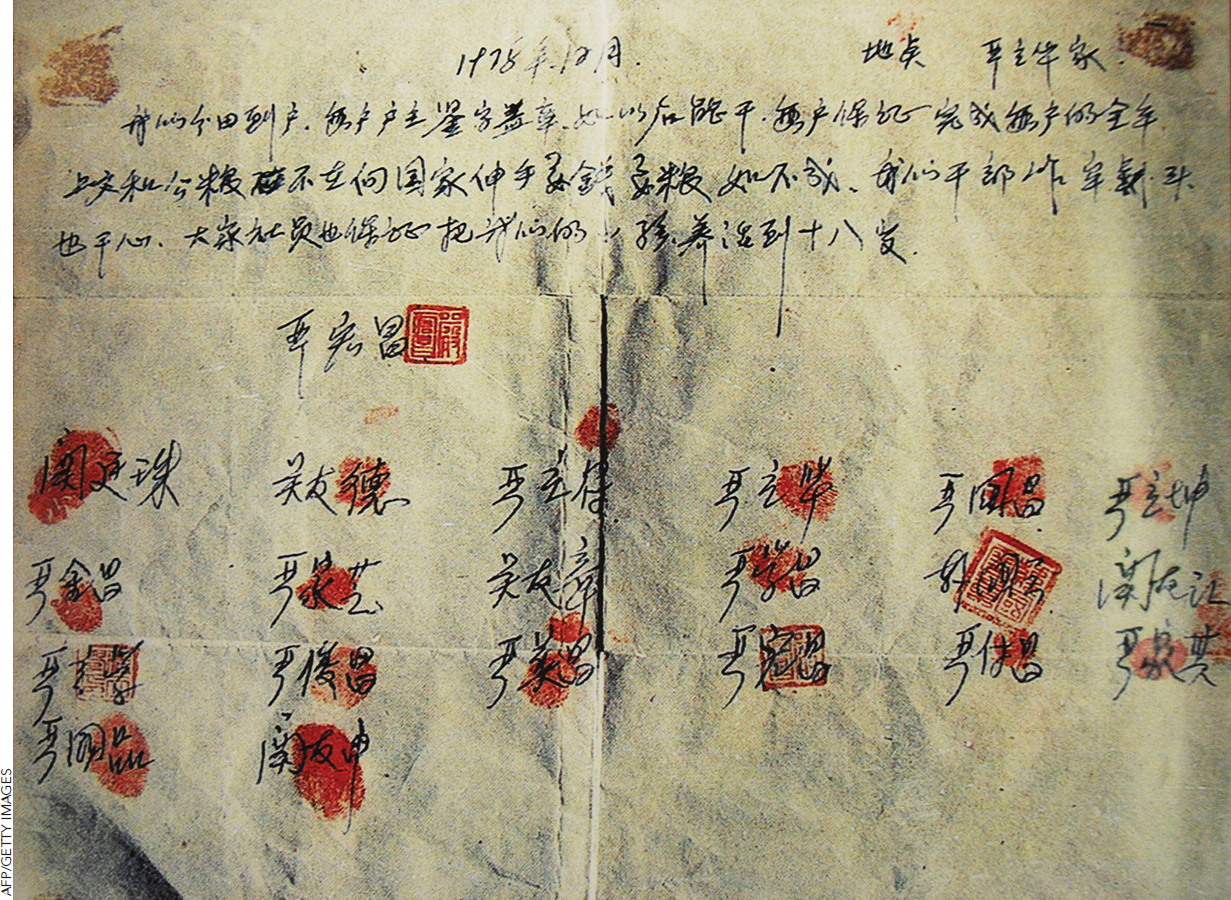
In the five short years between 1978 and 1983, when China’s central government endorsed individual farming, food production increased by nearly 50% and 170 million people were lifted above the World Bank’s lowest poverty line. Simply put, the increase in agricultural productivity brought about by the switch to individual farming was the greatest antipoverty program in the history of the world. By 1984, the collective farms were gone and soon after that China’s leader Deng Xiaoping announced a new government policy: “It is glorious to be rich.”
Property rights in land greatly increased China’s agricultural productivity. With fewer workers producing more food, more workers were available to produce other goods. To take advantage of its millions of workers, China opened up to foreign investment, making the label “Made in China” common throughout the world. With their secret pact, the farmers of Xiaogang had begun a second and more successful Chinese revolution.2
Property rights are important institutions for encouraging investment in physical and human capital, not just in agriculture but throughout the economy. It can take decades, for example, for an investment in a new apartment building or a factory to pay off. As we will discuss further in Chapter 9, savings are necessary to generate investment and thus growth. But why do people save and invest? Savers won’t save and investors won’t invest if they don’t expect that their property will be secure and they will receive a return for their savings and investment. Property rights are also important for encouraging technological innovation. For instance, investments in new pharmaceuticals take decades to pay off and they are risky—years of research and development sometimes have to be abandoned when the guinea pigs start to die unexpectedly. Just like farmers, investors and workers throughout the economy need to know that they will reap what they sow.
|
Top 10 Least Corrupt Countries |
|---|
|
Finland |
|
Singapore |
|
Sweden |
|
Iceland |
|
Netherlands |
|
Denmark |
|
New Zealand |
|
Norway |
|
United Kingdom |
|
Switzerland |
|
Source: World Bank, World Governance Indicators, 2000. |
|
Top 10 Most Corrupt Countries |
|---|
|
North Korea |
|
Afghanistan |
|
Somalia |
|
Liberia |
|
Equatorial Guinea |
|
Congo, Democratic Republic |
|
Angola |
|
Iraq |
|
Haiti |
|
Myanmar |
|
Source: World Bank, World Governance Indicators, 2000. |
Honest Government China under its former Communist rulers was extreme in abolishing most forms of private property. In many other countries, private property rights exist on paper—but only on paper. In a country like Zimbabwe, for example, an individual might have a legal right to land or a factory, but everyone knows that the government can take these goods at any moment. Zimbabwe lacks the rule of law.
More generally, corruption is like a heavy tax that bleeds resources away from productive entrepreneurs. Resources “invested” in bribing politicians and bureaucrats cannot be invested in machinery and equipment, thus reducing productivity. Corrupt government officials will also harass entrepreneurs, creating excessive rules and regulations that force entrepreneurs to pay them to stop making trouble.
Not all taxes are bad, of course. A tax that funds investment in roads, universities, or law and order can increase the productivity of private investments. Corruption, therefore, is a doubly bad tax because corruption makes it less profitable to be an entrepreneur at the same time as it makes it more profitable to be a corrupt politician or bureaucrat. At some point, corruption can feed on itself, creating a poverty trap: Few people want to be entrepreneurs because they know that their wealth will be stolen and thus there is no wealth to steal.
Figure 7.7 graphs corruption on the horizontal axis. The most corrupt countries like Somalia, Liberia, and North Korea are on the right, scoring about 2 on a 5-point scale running from -2.5 (least corrupt) to 2.5 (most corrupt). The least corrupt countries like Singapore, Iceland, the United States, and Norway are on the left. Real GDP per capita is on the vertical axis. Countries that are more corrupt have much lower per capita GDP.
FIGURE 7.7
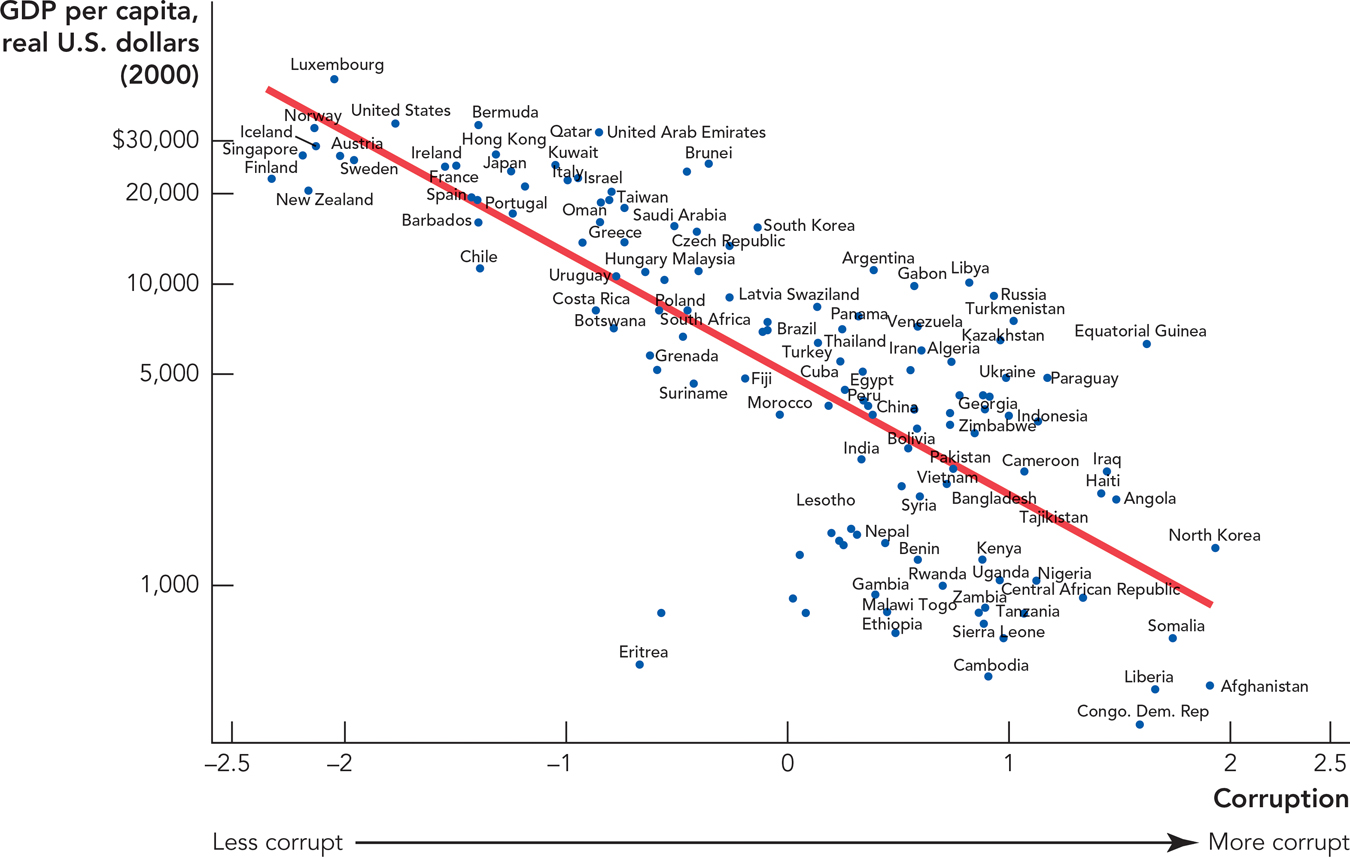
Source: Penn World Tables and World Bank Group, World Development Indicators, 2005.
Note: Not all countries are labeled. GDP on ratio scale.
Political Stability Investors have more to fear than government expropriation—sometimes the threat of anarchy can be even worse. Liberia, for example, has had little but conflict for the past 40 years. Prior to the election in 2006 of President Ellen Johnson-Sirleaf, the first elected female head of state in Africa, it had been 35 years since a Liberian president assumed office by means other than bloodshed. Both the previous two national leaders (Charles Taylor and Samuel Doe) consistently used the force of government to eradicate their opposition. Who wants to invest in the future when civil war threatens to wash away all plans?
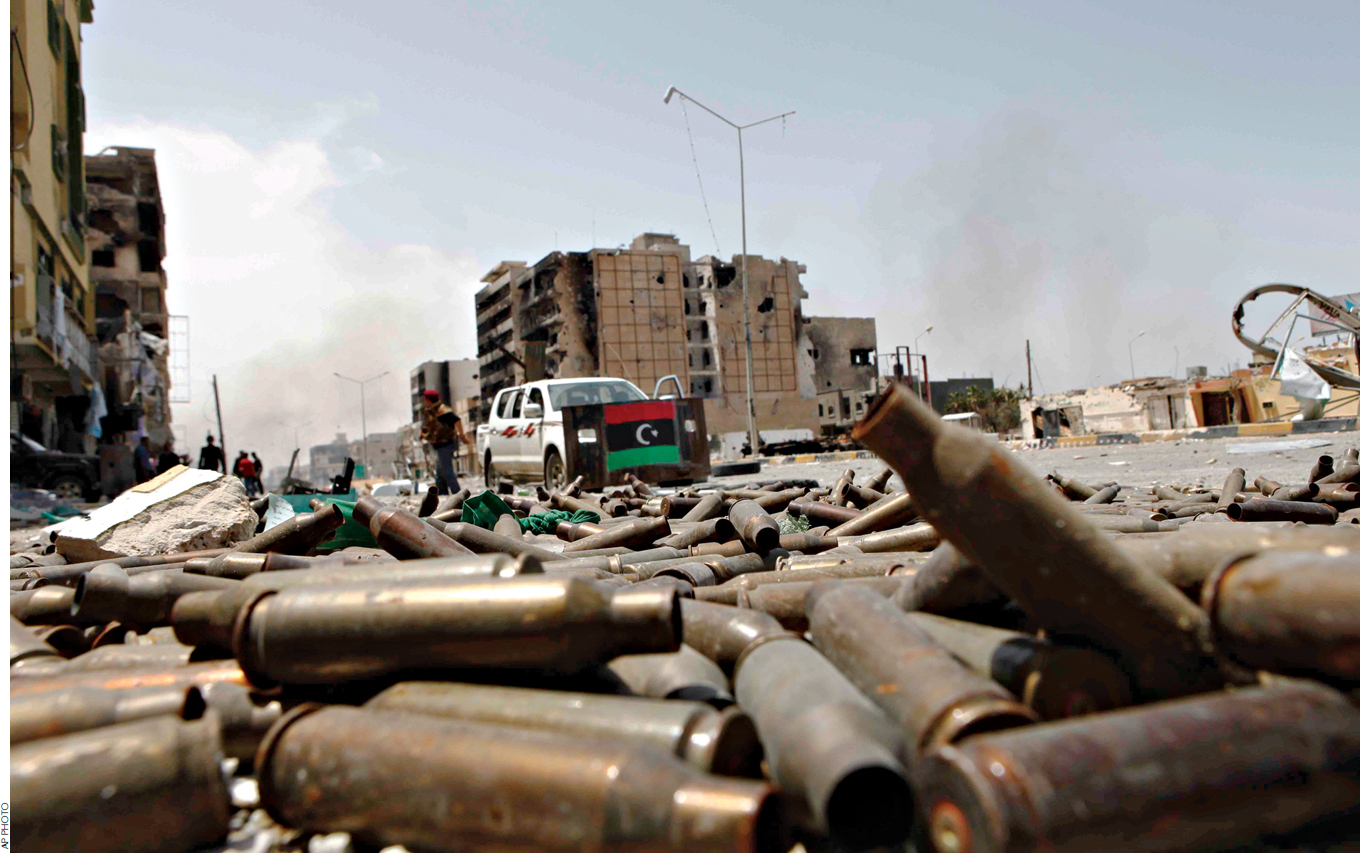
More generally, in many nations, civil war, military dictatorship, and anarchy have destroyed the institutions necessary for economic growth.
A Dependable Legal System The problem of poorly protected property rights is not always a problem of too much government—sometimes property rights are poorly protected because there is too little government. The legal system in many countries, for example, is of such low quality that no one knows for certain who owns what. In India, residents who purchase land often have to do so two or three times (from different parties), as there exists no reliable record of true ownership. A lawsuit, if you even bother to bring one, can take 20 years or more to resolve. In a major urban area, it’s very difficult to build something as simple as a supermarket because developers cannot acquire good title to a modestly sized piece of land. No one wants to build when they cannot protect their investment.
A good legal system facilitates contracts and protects private parties from expropriating one another. Few people think of the U.S. legal system as a paradigm of productivity, but it is compared to the Indian legal system. In the United States, for example, it takes 17 procedures and 300 days to collect on a debt (say, a bounced check). In India, it takes 56 procedures and 1,420 days to do the same thing. That’s one reason why it is difficult to borrow money in the first place: Lenders know how hard it is to get their money back.
Competitive and Open Markets The factors of production must not only be produced—they must also be organized. Detailed studies from a large number of countries suggest that the failure to organize capital efficiently has a huge effect on the wealth of nations. Poor countries are poor, in other words, not just because they lack capital but also because they use the capital that they do have inefficiently. Overall, about half the differences in per capita income across countries are explained by differences in the amount of physical and human capital (some of those differences in capital spring from deeper differences in institutions) and about half the differences are explained by a failure to use capital efficiently. One study, for example, estimates that if India used the physical and human capital that it does have as efficiently as the United States uses its capital, India would be four times richer than it is today.3
Why does India use its capital inefficiently? The reasons are numerous, but competitive and open markets are one of the best ways to encourage the efficient organization of resources. India, as well as other poor countries, has many inefficient and unnecessary regulations, which create monopolies or otherwise impede markets.
For instance, Indian shirts are usually made by hand in small shops of three or four tailors who design, measure, sew, and sell, all on the same premises. It sounds elegant but this is not Savile Row, the section of London where the finest tailors in the world create custom suits for the rich and powerful. Shirts would be cheaper and of higher quality if they were mass-manufactured in factories—the way shirts for Americans are produced. Why doesn’t this happen in India? Shirts in India are produced inefficiently because, until recently, large-scale production was illegal.
Economies of scale are the advantages of large-scale production that reduce average cost as quantity increases.
India prohibited investment in shirt factories from exceeding about $200,000. This restriction meant that Indian shirt manufacturers could not take advantage of economies of scale, the decrease in the average cost of production that often occurs as the total quantity of production increases. India has been reforming its economy, which is one reason why economic growth in India has increased in recent years (as we discussed in Chapter 6). India recently lifted the ban on large garment factories, for example, but many, many regulations remain that reduce the productivity of the Indian economy.4
Poor countries also suffer from expensive red tape. Economists at the World Bank have estimated the time and cost to do simple tasks such as starting a business or enforcing a contract in a court of law. In the United States, for example, it takes about 5 days to start a business and the total costs of the procedures are minor, less than 1% of the average income per capita. In Peru, starting a business takes 72 days and 32.5% of income per capita. In Haiti, it takes 203 days and the costs are 127% of income per capita. Thus, even before a business is begun, a Peruvian or Haitian entrepreneur must invest extensively in dealing with bureaucracies—that same physical and human capital is not being used to produce goods and services.
Markets can also be made more competitive and open with free trade. Most countries, for example, aren’t large enough to support more than a handful of auto manufacturers so free trade is necessary to keep auto manufacturers and other large firms competitive. Perhaps even more importantly, countries that are open to trade are also open to new ideas. Walmart made retailing more efficient in the United States and then it brought these efficiencies to other countries when it expanded internationally. Countries where Walmart was forbidden or discouraged from expanding gained these efficiencies more slowly, if at all. In fact, multinationals like Walmart are the best managed of all firms—they get the most output from the same quantity and quality of inputs—and multinationals are one of the best ways of spreading new and better ideas around the world.5
The Ultimate Causes of the Wealth of Nations
When China changed its institutions from collective farming to individual farming, agricultural productivity increased dramatically and China began to grow. The example of China is enormously encouraging because it suggests that growth miracles could become common if more countries changed their institutions. But take a look again at Figure 7.5. Institutions have a large effect on increasing and organizing the factors of production and thus institutions have a large effect on economic growth. But where do institutions come from? Are institutions products of geography? History? Ideas? Culture? Luck? Try “all of the above” and then some.
FIGURE 7.8
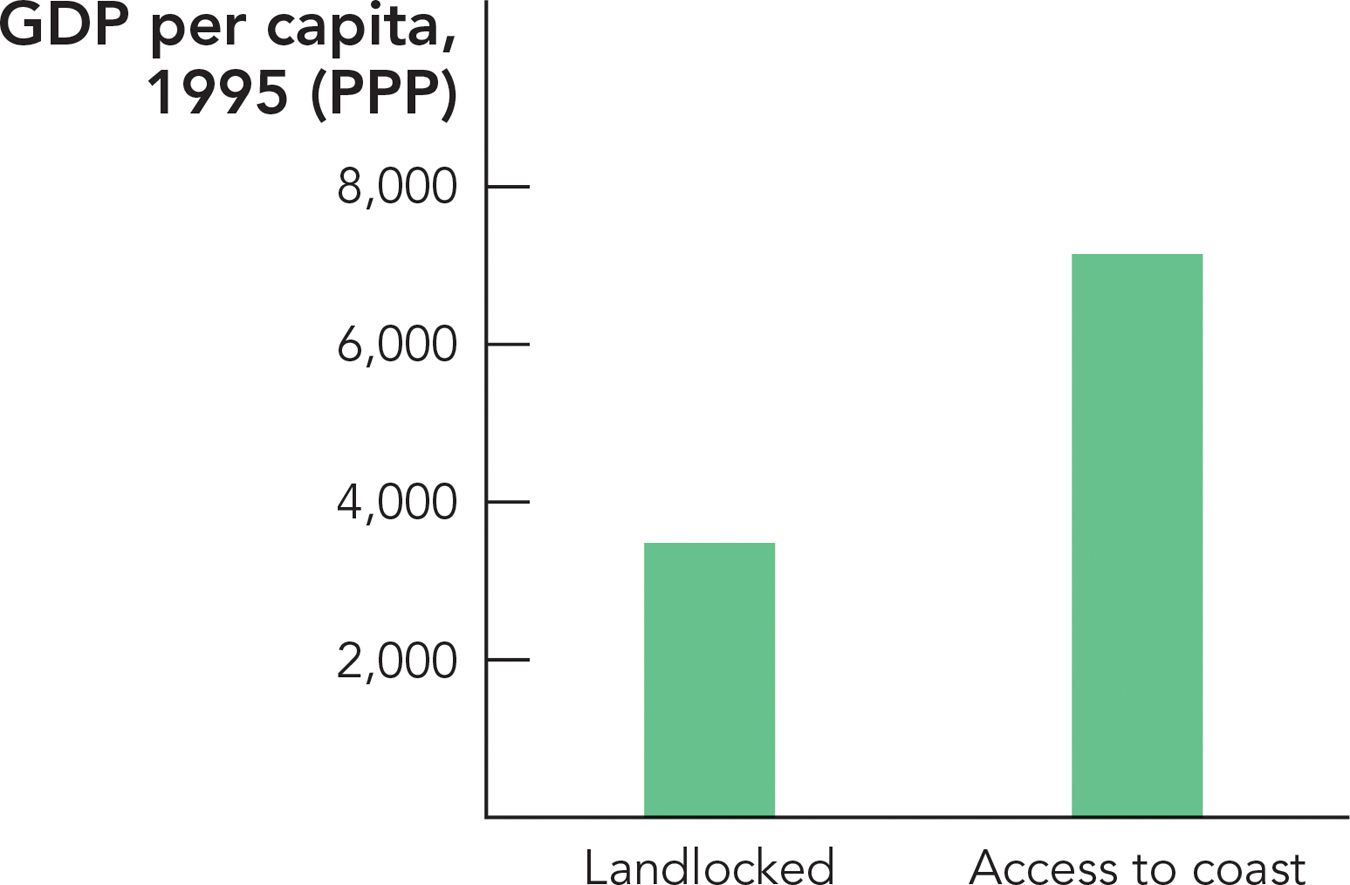
Source: Author calculations based on data from Gallup, Sachs and Mellinger (1999).
Consider geography, which we might also think of as a country’s “natural resources.” Simple natural resources like oil and diamonds are usually good to have but in rich, developed countries, physical and human capital are typically much more important. But natural resources more broadly conceived— climate, topography, and the prevalence of parasites, to give just a few examples—may help explain why a country is able to accumulate physical and human capital. We said earlier that free trade opens a country up to new ideas and innovation. But free trade is not just a matter of policy or choice—it also depends on natural conditions. It’s much cheaper to move goods and people over water than over land, so countries that have easy access to water are naturally more open to trade than countries that are landlocked. In fact, as Figure 7.8 reveals, landlocked countries have lower per capita GDP than countries that have access to a coast. It’s not that being landlocked dooms a country to poverty, but countries that are landlocked face the equivalent—from their natural setting—of permanently high tariff barriers. That can make it more difficult to generate growth, especially in the age before modern communications.
You can also see the importance of history, ideas, geography, and luck in the growth of the United States. The U.S. constitution was written at a time when the ideas of John Locke and Adam Smith were popular and it inherited a tendency toward a market economy and democratic institutions from its colonizer, Great Britain. An open frontier meant cheap land and plenty of freedom to try new ideas and ways of living, perhaps influencing America’s entrepreneurial culture even into modern times. And we are very lucky that George Washington had the virtue to stop at two presidential terms, rather than trying to become the next king.
An even more important example of a growth miracle comes from the Industrial Revolution, a period of sustained European technological advance, sometimes identified with 1770-1830 but that has deeper roots reaching back to the seventeenth century or earlier. The Industrial Revolution brought us large-scale factories, mass production, the steam engine, the railroad, and the beginnings of a consumer society, among many other benefits. It is the first time that human living standards climbed noticeably above subsistence and stayed there for a long period. We are all still enjoying the benefits of an ongoing industrial revolution in the world’s wealthy economies.
CHECK YOURSELF
Question 7.6
 List five institutions that promote economic growth.
List five institutions that promote economic growth.
Question 7.7
 In England during the Wars of the Roses (late 1400s), two parties fought for the crown. Contrast the prospects for economic growth during this period and after this period when Henry VII became the unquestioned head of the country.
In England during the Wars of the Roses (late 1400s), two parties fought for the crown. Contrast the prospects for economic growth during this period and after this period when Henry VII became the unquestioned head of the country.
Question 7.8
 When the Pilgrims landed at Plymouth Rock, they established a system of collective farming in which all corn production was shared. Given your understanding of incentives, what do you think happened to the Pilgrims?
When the Pilgrims landed at Plymouth Rock, they established a system of collective farming in which all corn production was shared. Given your understanding of incentives, what do you think happened to the Pilgrims?
The Industrial Revolution, centered in Great Britain, required a combination of multiple distinct advantages. Britain’s status as an island and the strong English Navy protected the country against invaders and made property rights more secure. Labor markets had been relatively free for centuries and the ethic of the time encouraged commerce, entrepreneurship, and the accumulation of wealth. The growth of the power of Parliament checked royal tyranny and encouraged economic policies that allowed wealth to spread more widely. Slow increases in agricultural productivity kept living standards above subsistence and enabled the rise of a professional class. Perhaps most important, Britain developed a strong culture of science and engineering and brought the scientific method to bear on economic production, whether it was designing a better spinning jenny or using coal to power a factory more effectively.
Once the initial takeoff of the Industrial Revolution was established, the positive feedback effects were strong. More wealth meant more people could devote their lives to science, invention, and turning new ideas into practical commercial developments. That in turn led to new wealth and then again to more applied science. Eventually the Industrial Revolution gave us electricity, the automobile, the flush toilet, and most of the other inventions that define the conveniences of modern life. To sum this all up, a lot of the Industrial Revolution had to do with good institutions for business, science, and governance.
No one understands for certain all the influences that go into creating a nation’s institutions, which means that changing institutions isn’t easy. When it comes to institutions, we know where we want to go but we don’t always know how to get there. Understanding institutions, where they come from, and how they can be changed is thus a key research question in economics.
